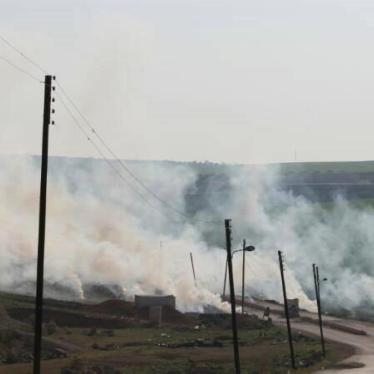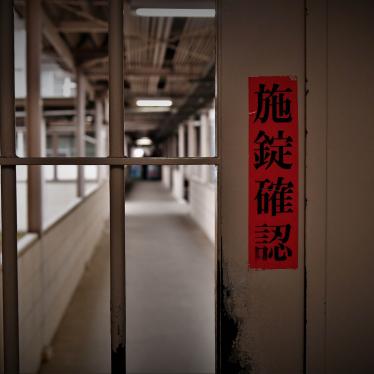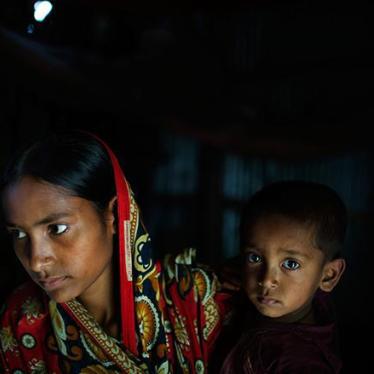(ベイルート)2014年12月以降にリビア国内の少なくとも2ヶ所で、禁止対象のクラスター爆弾使用を示す信頼性の高い証拠が見つかったと、ヒューマン・ライツ・ウォッチは本日述べた。
ヒューマン・ライツ・ウォッチが行った目撃者への電話インタビューと証拠写真の検討作業からは、RBK-250 PTAB 2.5Mクラスター爆弾の残骸が2015年2月にビンジャワドと3月にシルトで発見されたことが示唆される。爆弾の塗装の状態が良く、甚だしい風化が生じていないことは、残骸が長期間風雨にさらされてはおらず、最近の攻撃で使用されたことを示している。リビア空軍はこの2地点に最近爆撃を行ったが、クラスター爆弾の使用は否定している。入手できた証拠に基づいて責任の所在を確定することはできない。
「リビアでのクラスター爆弾使用を示す新たな証拠が見つかった。きわめて懸念すべき事態だ」と、ヒューマン・ライツ・ウォッチ武器局局長でクラスター爆弾連合(CMC)議長のスティーブ・グースは述べた。「リビア当局はこれらの事件を調査し、自軍がクラスター爆弾を使用していないことを確認すべきだ。」
2014年5月以降の戦闘により、リビアには複数の政府が存在する。国際社会が認知する東部政府と、リビア西部の大部分を支配下に置く民兵組織の連合体「ファジル・リビア(リビアの夜明け)」に支援されるトリポリ政府だ。両者は共に唯一の政治権力としての正当性を主張する。しかし全土を完全に掌握できてはいない。
3月11日、ヒューマン・ライツ・ウォッチは、国際社会が認知する東部政府のリビア空軍司令官Saqr al-Jeroushi准将に電話インタビューを行った。同准将は2月と3月にビンジャワドとシルトのほかにもワティヤなどを空爆したことを認めた。しかし指揮下の部隊はこれらの空爆実施地域でクラスター爆弾を一切投下していないと述べた。准将はリビア空軍はクラスター爆弾を使用できないと述べた。「民兵側への空爆は毎日続けています。しかしリビア軍が使用できるのは、第二次大戦で使われたような従来型の重火器用弾薬だけです」と准将は言う。「クラスター爆弾は保有していません。」
2014年5月以降、国際社会が認知する東部政府と連携するハリファ・ヒフタル将軍指揮下の部隊は、対「リビアの夜明け」軍事作戦を展開している。この「リビアの尊厳」作戦には、旧軍の構成員、部族勢力、山岳地帯の町ジンタンの民兵も参加している。リビアの夜明けには、ミスラタの勢力のほか、トリポリ、ザーウィヤ、サブラタなどの民兵が参加している。
シルトなど人口密集地でのクラスター弾頭の使用は、この兵器の無差別的性格により武力紛争法に違反する。クラスター爆弾は数十から数百発の小さな爆弾(子弾、小型爆弾)を1発の容器(ロケット砲、爆弾など)に内蔵したものだ。発射・投下後に容器が空中で開き、地上着弾時に爆発するように設計された子爆弾を散布する。子爆弾は広く無差別にばらまかれ、サッカー場程度の範囲に拡散することも多い。落下時にその場に居合わせた人全員を、戦闘員か民間人かの区別なく、死傷の危険にさらす。多くの子爆弾が着弾時の衝撃では爆発しないが、起爆装置は無効にならないため、事実上の地雷となる。不発弾化した子弾がある場所は、訓練を積んだ爆弾処理要員が除去作業を行うまで危険なままだ。
リビアは、いかなる状況でもクラスター爆弾の使用を禁じるとした2008年のクラスター弾に関する条約に加盟すべきだと、ヒューマン・ライツ・ウォッチは述べた。116ヶ国が締約国となる同条約は、クラスター爆弾の不発弾除去と被害者支援も義務づけている。ヒューマン・ライツ・ウォッチは国際組織「クラスター爆弾連合」の共同創設者で現在議長を務めている。
「大半の国がこうした兵器を禁じている。本質的に無差別的な性質があり、民間人に許容できない危害を加えるからだ」と、前出のグース局長は述べた。「国際社会が認知するリビア東部政府と本紛争当事国はクラスター爆弾の備蓄を速やかに保管し、すべて破壊すべきである。」
Recent Evidence of Cluster Munitions use in Libya
Sirte
On March 3, 2015, Brigade 166 fighters from the Libya Dawn alliance showed journalists a remnant of a tail of a bomb lying near one of their positions. From a review of the available photo evidence taken by international journalists, Human Rights Watch identified the weapon used as an RBK-250 PTAB-2.5M cluster bomb containing PTAB-2.5M submunitions. The good condition of the paint on the bomb casing and lack of extensive weathering indicates the remnant had not been exposed to the environment for long and is from a recent attack.
A journalist working for another international news outlet told Human Rights Watch that a commander from the Libya Dawn alliance had told him on March 3 that several cluster bombs hit and exploded near where the remnant had landed. The journalist said he observed holes purportedly showing the impact of submunitions.
On March 10, The New York Times reported that “similar munitions had evidently exploded nearby in recent days and left fragments of shrapnel in cup-size holes blasted into the dirt.” The report of small pock marks in the area suggests that some submunitions detonated on impact, Human Rights Watch said.
Bin Jawad
Several sources confirmed to Human Rights Watch that cluster munitions are also believed to have been used recently in the town of Bin Jawad, where the Libya Dawn alliance also has a presence, and near a front line by the port of Es-Sidr, where forces aligned with the internationally recognized government are fighting Dawn forces for control of oil terminals. The Libyan Air Force has carried out airstrikes there in recent months.
In the first week of February, Frederic Wehrey, a researcher for the Carnegie Endowment for International Peace, photographed several PTAB-2.5M submunitions in the rubble of the al-Wahda Bank in Bin Jawad. He said that a Libya Dawn commander told him that it was from an airstrike by the Libyan Air Force on or about January 9.
Human Rights Watch spoke by phone on March 11 with the Libya Dawn commander in charge of Bin Jawad, who said that the Libyan Air Force had dropped cluster bombs on at least two occasions in December 2014 and continued to drop them between January and March. He said the most recent attack, on March 6, 2015, killed a civilian at his farm. Human Rights Watch was unable to verify the death or its cause.
An international security adviser who visited Ben Jawad in February told Human Rights Watch that he had seen cluster munition remnants in various locations around the town, which he described as RBK-250 PTAB-2.5M cluster bombs. The good condition of the paint on the bomb casing and lack of extensive weathering indicated the remnants had not been exposed to the environment for long and were from a recent attack, Human Rights Watch said, after reviewing photo evidence.
Each RBK-250 PTAB-2.5M cluster bomb contains 30 PTAB-2.5M high explosive anti-tank (HE/AT) submunitions.
Watiya front – Western Libya
On February 27, a Facebook site run by a Libyan group calling itself the border guards unit posted photographs showing the remnants of a RBK-250-275 AO-1SCh cluster bomb, but no bomblets. The photographs were purportedly taken on the same date or shortly before at the Watiya front where Libya Dawn has been fighting forces aligned with Libya Dignity. Watiya is about 120 kilometers southwest of Tripoli.
Human Rights Watch has been unable to speak to anyone who was at the front during that period. The good condition of the paint on the bomb casing and lack of rust indicates that the remnants had not been exposed to the environment for long and were from a recent attack at the time the photograph was taken. Each RBK-250-275 AO-1SCh cluster bomb contains 150 AO-1SCh antipersonnel fragmentation bomblets.
On February 12, a photograph posted on the Facebook page of a Libyan satellite TV station showed two men wearing fatigues, one of which had Libyan army insignia, standing in front of an RBK-250 PTAB-2.5M cluster bomb affixed to a military aircraft. The provenance of the photograph is unclear but writing on the bomb refers to the Jordanian Pilot Moadh al-Kasasbeh, who was killed by the extremist group Islamic State, also known as ISIS, in February, suggesting it is a recent image.
Previous Use of Cluster Munitions by Libyan Forces
Libya is not known to have produced or exported cluster munitions, but in the past it imported and stockpiled the weapons. According to Handicap International, Libyan government forces used air-delivered cluster munitions at various locations during its intervention in Chad during the 1986-1987 conflict, likely RBK-series cluster bombs containing AO-1SCh and PTAB-2.5M submunitions.
Based on remnants identified by Human Rights Watch and others at the scene of cluster munition attacks as well as weapons located at storage facilities since the 2011 conflict, Libya’s stockpile of cluster munitions included at least air-dropped bombs (RBK-series containing AO-1SCh and PTAB-2.5M bomblets), surface-fired munitions (MAT-120 mortar projectiles), and an unknown type of submunition contained in 122mm rockets. The size of the stockpile of those weapons is unclear.
During the 2011 conflict, government forces loyal to Muammar Gaddafi used three different types of cluster munitions at various locations. Human Rights Watch witnessed government forces fire ground-launched MAT-120 mortar cluster munitions in Misrata in April 2011. In early 2012, clearance teams from the UK charity Mines Advisory Group and the UN found the remnants of an RBK-250 cluster bomb and about 30 PTAB-2.5M submunitions near the city of Ajdabiya, where Libyan government aircraft carried out airstrikes in March 2011. The UN Commission of Inquiry on Libya reported in 2012 that submunitions and 122mm cargo rockets used by the Libyan government were also found in the Nafusa Mountains near Jadu and Zintan.
There is no evidence of cluster munition use in Libya by countries involved in the NATO military action in 2011. NATO formally confirmed to the UN Commission of Inquiry on Libya that its forces did not use cluster munitions in the Libya operation. However, NATO airstrikes in 2011 on ammunition storage facilities created hazards when munitions stored by Libya, including cluster munitions, were ejected into the surrounding environment.
In March 2012, Human Rights Watch visited a storage depot in Mizdah, 160 kilometers south of Tripoli, which had been attacked more than 50 times by NATO between April and July 2011. Human Rights Watch found approximately 15 PTAB-2.5M bomblets and about three dozen submunitions of an unidentified type.
When the Gaddafi government was overthrown in 2011, anti-government forces and civilians gained access to weapons depots containing hundreds of thousands of landmines and other weapons, including cluster munitions. There has been no systematic or coordinated stockpile destruction effort by successive interim governments, or international actors.








